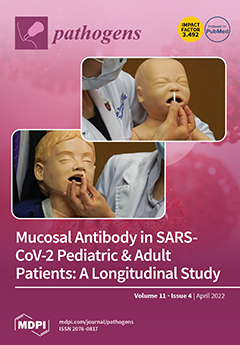Leptosphaeria maculans is one of the major pathogens of oilseed rape (
B. napus). It causes blackleg disease, which accounts for significant yield losses worldwide. Using cultivars that harbor major resistance (
R) genes is one of the most effective control
[...] Read more.
Leptosphaeria maculans is one of the major pathogens of oilseed rape (
B. napus). It causes blackleg disease, which accounts for significant yield losses worldwide. Using cultivars that harbor major resistance (
R) genes is one of the most effective control methods. However, the efficacy of major
R genes is related to the frequency of the corresponding avirulence (
Avr) genes in a
L. maculans population. In this paper, we report the
Avr profiles of
L. maculans populations and the ratio of its mating types in Northern and Central regions of Germany. Eleven
Avr genes in five-hundred and seventy-four isolates were characterized either by applying cotyledon tests on a
B. napus differential set or by amplifying avirulence gene-specific PCR markers. Fifty-two races were determined, among which the most dominant race was
Avrlm6, -7, -11, AvrlepR1, -R2. Results showed that the resistance gene
Rlm2 is 100% ineffective, some other major
R genes such as
Rlm1, Rlm3,
Rlm4 and
LepR3 are partially effective (with corresponding
Avr frequencies ≤ 42%), while
LepR1,
LepR2,
Rlm6,
Rlm11 and
Rlm7 can still provide relatively effective resistance in the German fields investigated (with corresponding
Avr frequencies of 63–100%). Sexual reproduction is a factor that enhances the potential of
L. maculans to evolve under selection pressure. Mating types of the
L. maculans populations did not deviate from the ratio of 1:1 in the examined regions, indicating that sexual reproduction and ascospores play central roles in the
L. maculans lifecycle. Overall, this study provides an important dataset for the establishment of a strategic plan to preserve the efficacies of major
R genes in Germany by applying cultivar rotations of oilseed rape.
Full article






